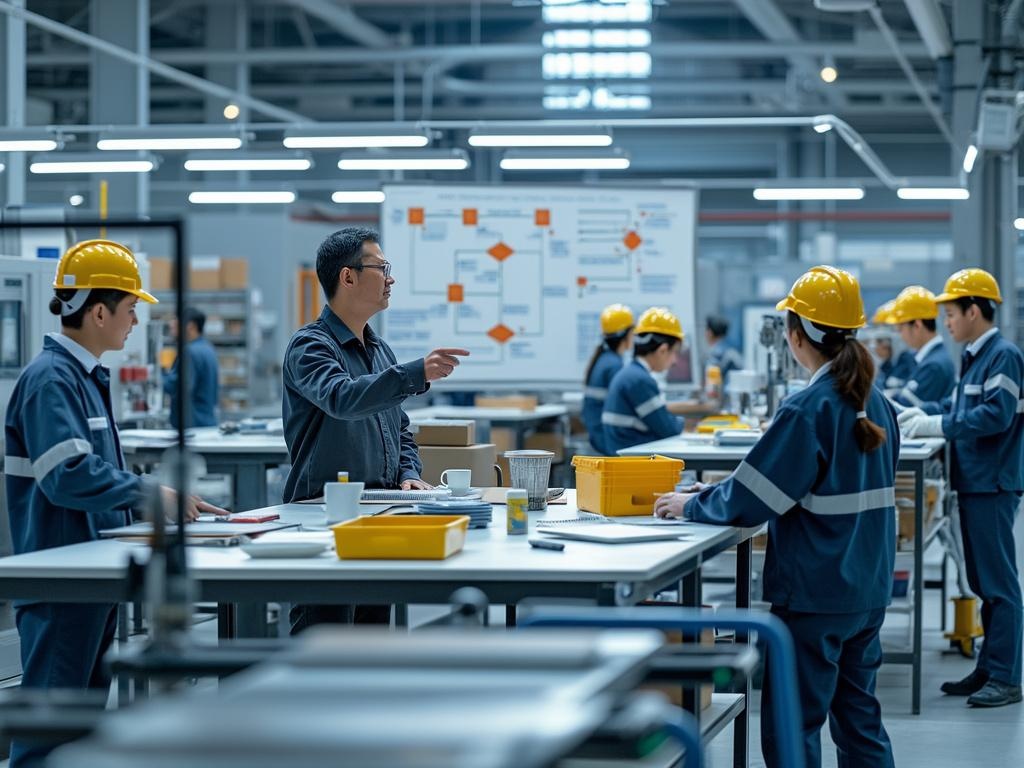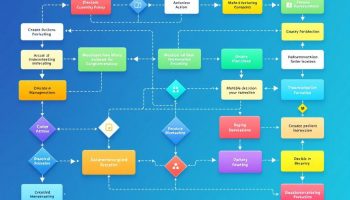
Kaizen for production offers a structured approach to achieving continuous improvement in manufacturing through small, employee-driven changes. This Japanese methodology eliminates waste, boosts efficiency, and optimizes workflows through systematic refinements rather than complete overhauls.
Why Businesses Need Kaizen for Production
Kaizen for production gives manufacturing organizations a competitive advantage in today’s challenging market by cutting costs while enhancing quality and delivery times. When properly implemented, this approach transforms workplace culture by enabling frontline staff to spot inefficiencies and create solutions, leading to lasting productivity improvements rather than quick fixes. Manufacturing leaders who adopt kaizen principles develop flexible operations that adapt to market shifts while driving operational excellence through small, meaningful changes that accumulate over time.
By implementing Kaizen principles, companies can see a 50% reduction in waste, translating into significant cost savings and improved product quality.
Implementing Kaizen for Production: A Practical Guide to Continuous Improvement
Kaizen for production offers a transformative approach to manufacturing by focusing on consistent, incremental improvements. This Japanese philosophy can revolutionize your production floor by systematically eliminating waste, boosting quality, and increasing efficiency without requiring massive overhauls. The beauty of kaizen implementation lies in its accessibility—creating meaningful change through small, manageable steps that accumulate into significant results.
Your production teams become the driving force behind positive change when kaizen principles are applied correctly. Staff at all levels learn to spot inefficiencies, create practical solutions, and implement improvements that deliver tangible outcomes. This approach democratizes the improvement process, making quality enhancement everyone’s responsibility rather than restricting it to management.
The journey starts with a comprehensive assessment of your current operations before progressing through team development, clear goal setting, and structured improvement cycles. Success depends equally on technical systems and human engagement—your employees need proper training, genuine empowerment, and motivation to actively participate in improvement initiatives. By establishing these fundamentals, your organization can achieve sustainable production enhancements that adapt to market shifts while maintaining a competitive edge through operational excellence.
1. Assess Current Production State
To successfully implement kaizen for production, you must first understand your starting point. Begin by conducting comprehensive baseline performance measurements of your current manufacturing processes. Document your existing workflows, production sequences, and resource allocation strategies through direct observation and data collection. Implementing kaizen for production requires identifying critical bottlenecks and pain points that impact efficiency and quality.
Create detailed process maps that visualize your production flow, highlighting areas where waste occurs or where value isn’t being added. Use quantitative metrics such as cycle time, throughput, defect rates, and equipment efficiency to establish your baseline. Consider using value stream mapping software to identify inefficiencies and value-adding activities.
When assessing your production state, involve operators and supervisors who work directly with processes daily—they often have invaluable insights about what’s working and what isn’t. This initial assessment phase provides the foundation for all future kaizen improvements and helps prioritize which areas need attention first.
2. Form Kaizen Teams
Creating effective kaizen for production teams requires strategic selection of members from diverse departments. When building your teams, include representatives from production, quality control, maintenance, and management to bring varied perspectives to problem-solving efforts.
Assign clear roles to each team member based on their expertise and strengths. The team should typically include a leader who facilitates meetings, a recorder who documents discussions, and members who contribute specialized knowledge. Establishing these defined responsibilities prevents confusion and ensures accountability throughout the improvement process.
Set up robust communication channels to keep information flowing between team members and across departments. Consider implementing effective project collaboration methods such as daily stand-up meetings, digital task boards, and regular progress reports. These channels help team members share insights, report obstacles, and celebrate successes.
Your kaizen teams should meet regularly to analyze processes, identify waste, and develop improvement solutions. Schedule these meetings at consistent times and create an environment where all team members feel comfortable contributing ideas regardless of their position in the organization.
Expert Insight: To form effective kaizen teams, select diverse members from various departments and assign clear roles, including a facilitator and a recorder. Establish strong communication channels through daily meetings and digital tools to ensure continuous sharing of insights. Regular meetings foster an open environment for idea contribution and process improvement.
3. Set Clear Improvement Goals
Implementing kaizen for production requires establishing well-defined objectives that guide your continuous improvement efforts. Start by defining specific, measurable goals that directly address your production challenges. When formulating these targets, ensure they align with your overall business objectives while focusing on areas where kaizen principles can deliver meaningful results.
Create a detailed timeline with strategic milestones to track progress throughout your kaizen implementation journey. These checkpoints help maintain momentum and allow for timely adjustments to your approach. Developing clear success metrics is equally important—quantify what improvement looks like in terms of reduced waste, increased efficiency, or enhanced quality.
Consider these key metrics when setting your kaizen for production goals:
- Reduction in defect rates (measured as percentage decrease)
- Decrease in production cycle times
- Improvement in overall equipment effectiveness (OEE)
- Reduction in inventory costs
Your goals should be ambitious yet attainable, providing a clear direction for continuous improvement activities. When properly established, these objectives will serve as the foundation for successful kaizen implementation throughout your production environment.
Expert Insight: Set specific and measurable improvement goals that align with your business objectives to guide your kaizen efforts. Establish a timeline with strategic milestones to track progress, and develop clear success metrics to quantify improvements. Ensure your goals are ambitious yet attainable to support continuous improvement in production.
4. Implement PDCA Cycle for Kaizen Production Improvement
Implementing the PDCA (Plan-Do-Check-Act) cycle is a fundamental component of kaizen for production environments. When applying kaizen for production, start by developing detailed action plans that address specific problem areas identified during your assessment phase. These plans should include resource allocation, timeline estimates, and clear responsibilities for each team member.
During the “Do” phase, execute your improvements on a small scale first. This controlled implementation of kaizen for production allows you to test changes without disrupting the entire production line. Try implementing one change at a time to accurately measure its impact.
The “Check” phase involves measuring results against your predetermined goals. Use data collection tools to track key metrics like production output, defect rates, or cycle times. Continuous improvement requires honest assessment of both successes and failures.
Finally, in the “Act” phase, standardize successful changes across your production floor. Document new procedures, update work instructions, and train all relevant staff. When implementing kaizen for production, remember that PDCA is cyclical – once you standardize improvements, begin planning the next round of enhancements to further optimize production methods.
Expert Insight: Utilize the PDCA cycle in kaizen by planning targeted improvements, testing them on a small scale, and measuring their impact. Analyze results to differentiate successes from failures, and standardize effective changes. Embrace the cyclical nature of PDCA to continually enhance production processes and foster ongoing efficiency.
5. Train and Empower Employees for Effective Kaizen for Production
Employee training and empowerment form the backbone of successful kaizen for production implementations. When team members understand the principles and techniques of kaizen, they become active participants in the continuous improvement process rather than passive observers.
Begin by providing comprehensive training on kaizen fundamentals, including waste identification, problem-solving methodologies, and process mapping. These skills enable employees to spot improvement opportunities that might otherwise go unnoticed. Consider implementing kaizen practices through workshops where teams can apply techniques to actual production challenges.
Develop robust problem-solving capabilities by teaching:
- Root cause analysis techniques
- Statistical process control methods
- Structured problem-solving frameworks like 5 Why and A3
- Visual management tools
Encourage employees to submit improvement suggestions through a formalized system. This creates ownership and demonstrates that management values their input. Production teams often identify practical solutions that management might miss due to their daily interactions with processes.
Set aside dedicated time for improvement activities and recognize contributions publicly. This reinforces the importance of continuous improvement in your production environment and builds a sustainable kaizen culture where improvements become self-perpetuating.
Expert Insight: To foster effective kaizen for production, invest in comprehensive employee training and create a formal system for improvement suggestions. Encourage problem-solving techniques and allocate dedicated time for improvement activities. Publicly recognize contributions to cultivate a sustainable culture of continuous improvement that empowers employees and enhances productivity.
6. Monitor and Measure Progress
To successfully implement kaizen for production, you must track progress consistently. Establish key performance indicators (KPIs) that align with your improvement goals, focusing on metrics like cycle time, defect rates, and productivity improvements. Regular measurement creates transparency and visibility into how your kaizen initiatives are performing.
Document both improvements and setbacks in a centralized location. This documentation serves as a valuable historical record that highlights progress patterns and helps identify recurring challenges. When implementing continuous improvement strategies, these records become essential learning tools.
Adjust your strategies based on the collected data rather than assumptions. Data-driven decision making is central to kaizen philosophy and helps eliminate subjective biases. Consider implementing the following measurement practices:
- Daily performance boards visible to all team members
- Weekly kaizen review meetings to assess progress
- Monthly trend analysis reports comparing current and past performance
- Quarterly strategic reviews to align improvements with business objectives
Remember to celebrate small wins along the way. Recognition reinforces the value of the kaizen for production approach and maintains team motivation through the continuous improvement journey.
7. Standardize and Scale Success
After implementing kaizen for production improvements, it’s essential to document and standardize successful processes. When you’ve identified what works well, create clear documentation that captures these winning approaches. This documentation becomes the foundation for implementing consistent standards across all production operations.
Start by creating detailed standard operating procedures (SOPs) that outline the exact steps of each optimized process. These SOPs should incorporate the kaizen for production principles that led to the improvement. Consider using visual aids like flow charts and images to make these standards easier to understand and follow.
Next, develop a systematic approach to sharing best practices across different teams and departments. This might include:
- Regular cross-functional meetings to showcase successful kaizen implementations
- A digital knowledge repository accessible to all production teams
- Peer-to-peer training programs led by teams who achieved significant improvements
Remember that standardization isn’t about rigidity but creating a new baseline for continuous improvement. When you effectively scale successful kaizen initiatives, you create a multiplier effect throughout your production environment, maximizing the return on your improvement efforts.

Kaizen for production is a systematic approach to continuous manufacturing improvement through incremental, employee-driven changes that eliminate waste and enhance efficiency. This methodology transforms production environments by implementing a seven-step framework that begins with thorough assessment and culminates in standardizing successful changes, creating a self-sustaining cycle of operational excellence.
Implementing kaizen for production delivers significant competitive advantages for businesses through measurable efficiency gains and quality improvements. Organizations that adopt this methodology experience reduced operational costs, enhanced product quality, increased employee engagement, and greater adaptability to market changes—all critical factors in today’s demanding manufacturing landscape where continuous improvement has become essential rather than optional.
Mastering Kaizen Implementation
Implementing kaizen for production requires a methodical approach across seven critical steps, from assessing current operations to standardizing successful improvements. This process creates a foundation for sustainable manufacturing excellence through continuous employee engagement, systematic problem-solving using PDCA cycles, and data-driven decision making. By fostering cross-functional teams with clear roles and establishing measurable goals aligned with business objectives, organizations develop a self-reinforcing improvement culture that delivers ongoing efficiency gains and operational excellence.
Key Implementation Checklist
- Conduct comprehensive baseline assessments of current manufacturing processes
- Form diverse kaizen teams with representatives from multiple departments
- Establish specific, measurable improvement goals with clear timelines
- Implement the PDCA cycle for systematic problem-solving
- Provide comprehensive training on kaizen fundamentals to all employees
- Create formalized systems for improvement suggestions
- Track progress with meaningful KPIs aligned with improvement goals
- Document both improvements and setbacks in a centralized repository
- Standardize successful processes through detailed SOPs
- Develop systems for sharing best practices across different departments
Frequently Asked Questions
What is the difference between kaizen and continuous improvement?
Kaizen is a Japanese philosophy meaning “change for better” that emphasizes ongoing, incremental improvements involving all employees, while continuous improvement is the broader concept. Kaizen is essentially a specific approach to continuous improvement characterized by its focus on small, manageable changes and strong employee involvement.
How long does it typically take to see results from kaizen in production?
Small improvements can be visible within weeks, but significant, measurable results typically emerge within 3-6 months of consistent implementation. The timeframe varies depending on the complexity of processes, organizational culture, and employee engagement levels.
Do we need external consultants to implement kaizen for production?
While external guidance can accelerate implementation, especially for organizations new to lean methodologies, kaizen can be successfully implemented using internal resources if you invest in proper training and empower your teams with the necessary knowledge and tools.
How do we maintain momentum with kaizen initiatives?
Maintain momentum by celebrating small wins, recognizing employee contributions, consistently measuring progress against goals, conducting regular kaizen events, and ensuring leadership visibly supports the continuous improvement culture.
What’s the relationship between kaizen and other lean manufacturing tools?
Kaizen serves as the philosophical foundation for many lean tools like 5S, Value Stream Mapping, and Total Productive Maintenance. While these tools address specific aspects of improvement, kaizen provides the overarching mindset and approach that makes these tools effective within a continuous improvement framework.






